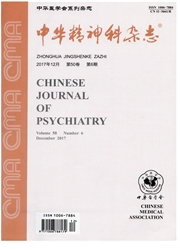

 中文摘要:
中文摘要:
目的 探讨首次发病和复发抑郁症患者与健康对照者脑白质结构网络中表示节点连接疏密程度的度属性值异同.方法 对29例首次发病抑郁症患者(首发组)、20例复发抑郁症患者(复发组)、57名健康对照者(对照组)进行弥散张量成像检查,利用解剖学自动标记模板将整个大脑划分为90个区域,同时对全脑进行确定性纤维追踪,构建脑白质结构网络.比较首发组、复发组与对照组,以及首发组与复发组间脑网络节点度属性值的差异;并分析差异脑区与患者临床特征的相关性.结果 (1)首发组左侧壳核度属性值(11.83±2.28)较对照组(13.95±2.33;t=-4.02,P=0.000 13,通过校正)下降;(2)复发组节点度属性值(右侧背外侧额上回:7.80±1.43;左侧壳核:11.75±2.07)较对照组(9.70±2.89,13.95±2.33;t=-3.81、-3.73,P=0.000 31、0.00037,通过校正)下降;(3)复发组右侧背外侧额上回度属性值(7.80±1.44)较首发组(9.62±1.78;t=-3.80,P=0.000 42,通过校正)下降;(4)首发、复发组与对照组脑网络核心节点分布区域类似,其中左侧壳核为共同的核心节点;(5)抑郁症患者右侧背外侧额上回度属性值与抑郁发作次数(r=-0.42,P=0.002 6)、病程(r=-0.41,P=0.003 7)呈负相关.结论 抑郁症患者额叶皮质及壳核的结构连接紧密性下降.其中,壳核在脑网络中处于重要地位,其所连接纤维受损是首次发病和复发抑郁症患者共同的结构改变;而额叶所连接纤维受损与抑郁症患者病程的复发性相关.
 英文摘要:
英文摘要:
Objective To explore the differences of the degree indicating the density of the connectivity of nodes between the brain structural white matter networks in the first-episode (FD),recurrent (RD) depressed patients and the healthy control (HC) subjects.Method The diffusion tensor imaging data were obtained from 29 FD patients,20 RD patients and 57 HC subjects.The whole cerebral cortex was divided into 90 regions by the anatomical label map.Fiber tracking was performed in the whole cerebral cortex of each subject to reconstruct white matter tracts of the brain using the fiber assignment by continuous tracking algorithm.And then the brain structural networks were constructed using the complex network theory.The nodal degree of the brain networks of FD and RD were compared with that of HC,and then the correlations between the degree of the significant nodes and the clinical features of patients were explored.Result The degree of the nodes in the networks of FD descended significantly in the left putamen (11.83 ±2.28) when compared with HC (13.95 ±2.33;t =-4.02;P =0.000 13,survived correction).That of RD descended significantly (the right dorsolateral superior frontal gyrus (7.80 ±1.43);the left putamen (11.75±.07 when compared with HC (9.70 ±2.89,13.95 ±2.33;t=-3.81,-3.73;P =0.000 31,0.000 37,survived correction).That of RD descended significantly in the right dorsolateral superior frontal gyrus (7.80 ±1.43) when compared with FD (9.62 ±1.78;t =-3.80;P =0.000 42,survived correction).The distribution of the hub regions in the patient and healthy were similar and the left putamen was the same hub region for both groups.Significant negative correlations were found between the degree of the right dorsolateral superior frontal gyrus and the number of episodes (r =-0.42,P =0.002 6) and the course of the disease (r =-0.41,P =0.003 7) in the patient.Conclusions The degree of the connectivity between the frontal region and putamen are possibly decreased in the depressed
 同期刊论文项目
同期刊论文项目
 同项目期刊论文
同项目期刊论文
 期刊信息
期刊信息
